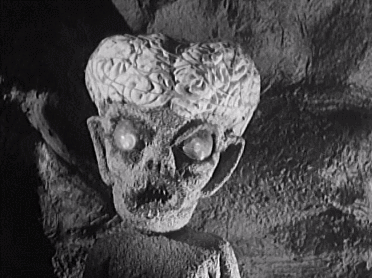Conquistador de la Luna
aka Conqueror of the Moon

1960![]()
Story by José María Fernández Unsáin
Adapted by Alfredo Varela
Directed by Rogelio A. González

Conquistador de la Luna (Conqueror of the Moon) is a Mexican science fiction comedy that deals with a bumbling genius and his adventure after accidentally getting blasted to the moon and meeting the evil moon aliens. Who are totally not where they got the ideas for Sleestaks from! These Moon Sleestaks clearly have four arms, thank you very much!
Despite being a cornball comedy featuring a Mexican comedian with a one-word nickname (we’ve all learned from FourDK that one-word nicknames on Mexican comedians are a warning signal that only brings pain!), there are some inventive elements that borrow from classic American and British alien and space travel films. The Martians found on the Moon have four arms and appear to be green in appearance in what I can only believe is a reference to the John Carter of Mars stories from Edgar Rice Burroughs.

The Great Brain of Mars is a complete non-humanoid creature with an all-seeing eye on a stalk and a big box that the brain is housed in. Like all movie monsters, he can’t resist Mexican women, and when one practically lands in his doorstep, he’s hot to trot to mate with her. Since he’s a brain in a box with an eye tentacle that oozes bubbly liquid, exactly how this mating will occur gets grosser and grosser the more you think about it. And he doesn’t care about consent, because the Great Brain is just going to hypnotize Estela to get the job done. Never fear, there is a man around to rescue her, even if he’s not much of a man.
If Conquistador de la Luna is strongest in one effect, it is in the alien costumes and design. The Sleestaks are just human enough to have recognizable emotions, but just alien enough to be menacing. The Great Brain’s entire setup is impressive, and calls back to the fun era of 1950s science fiction drive-in films with it’s creatively weird design straight out of Roger Corman.

Outside of the costumes, Conquistador de la Luna has some practical effects mixed in with some visual tricks. During the rocket sequences, the effects of g-force are shown by the actors’ reflections being contorted. G-force is one of those things that space movies stopped using decades ago, but talking guinea pig movies are still using. There is also a big bag of stock footage “borrowed” from other recent rocketship films, for those of you who like to play the “Where is that from?” game. There are visual effects rocketship shots created just for the film, especially during the climactic showdown to save the planet.
If the writing and directing credits (Story by José María Fernández Unsáin, adapted by Alfredo Varela, directed by Rogelio A. González) look familiar, that’s because they are identical to fellow 1960 Mexican science fiction film La Nave de los Monstruos/Ship of Monsters. Alfredo Varela would adapt dozens of stories by José María Fernández Unsáin through the 50s and 60s. By 1970, José María Fernández Unsáin had moved on to adapting his own scripts and even directing some of them. Alfredo Varela both wrote and acted through the 50s to the 70s.
Enough of that jazz, it’s time to conquer the moon!


|
















